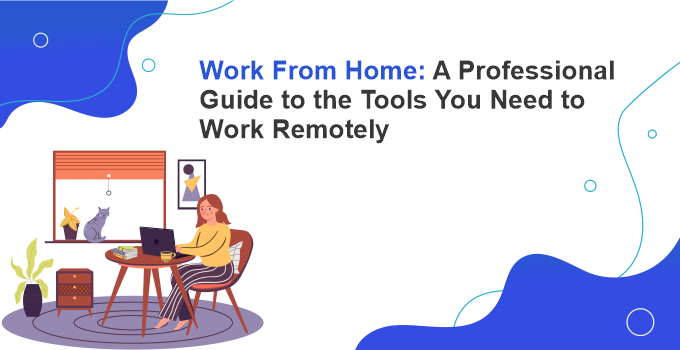Work from Home: Guide to The Tools You Need to Work Remotely
Working at home can give you more control over your schedule. It can also help you focus on a specific task without being distracted by the phone ringing, co-workers, or kids, and it will allow you to be more productive. There are many ways to work remotely, and while most are not the best options for professional development, some are.
This article will guide you towards finding the tools that allow you to be more productive and to work more flexibly than you ever thought possible. To work from home professionally, you need the right resources and equipment. I’ll show you what makes a great working from home setup.
List of Professional Productive Tools
Here is a brief list of pro productivity tools:
- Top Productivity Tools: Avoma, Klaus, Blink
- Time Management Tools: Kickidler, Timely, Toggle
- Project Management Tools: Jira, Trello, Basecamp3
- Documents Sharing Tools: Front, Zapier
- Communication Tools: Zoom, Skype, Slack
Now let’s know about these tools in detail.
1.Avoma
Maintaining and improving a successful business is not a single action but a series of them. You need to be able to identify which steps you need to take to reach the next level. This is where the Avoma productivity tool comes in.
Through utilizing the Avoma tool you can evaluate the current state of your business and identify the steps needed to reach success. Whether it is improving your sales or your customer support, gaining more knowledge about your business can put a dent in your stress level and make you more efficient at doing what you do best.
2.Klaus
When people drop in and out of a team, it’s natural for the quality of their work to suffer. Klaus is a customer feedback tool that allows you to gauge customer happiness and satisfaction using survey results.
Moreover, Aircall is a tool that records calls with your customer service representatives and allows you to listen to the calls and provide feedback on them.
Click here to read: The Best Customer Success Software
3.Blink
Blink is a business application for teams and organizations with distributed members that helps keep the team connected at all times. It transforms employee experience from being disjointed and fragmented to being connected and cohesive.
Blink is a program with a bunch of stuff that will make your time on the computer more productive. These include event calendars, discussion boards, and employee directories.
4.Kickidler
Kickidler is customer relationship management software that offers you different tools to track and manage your team members. Kickidler helps you turn your team’s work into something predictable and satisfying.
Kickidler has a bunch of neat features for easily tracking employees’ computer use and for keeping track of time. You can see how long employees have been at their computers or how much they work each day, all at a glance.
To help make supervisor monitoring more democratic, the system designers released a new feature called Autokick that help make the supervisor more accountable. The update includes a new interface for notifications and self-monitoring. It also includes automatic notifications. Now the program will automatically show how much time workers have spent working. You’ll be able to see how productive your co-workers are, and also how receptive they are to feedback.
5.Timely
For people who want to create dedicated time to work on side-projects or even full-time projects, Timely is a great way to keep track of time spent on specific tasks. Timely is unlike some other time tracking systems in that it allows you to schedule tasks and track time spent in real-time, as opposed to only while you are working. It helps you track your work hours, earnings, and deadlines. Its interface is simple enough that you can use it on the go.
6.Toggle
If you need to track how much time you’ve spent on various activities, or if you have employees to keep track of, then Toggle is a good tool. It’s a good tool for personal productivity measuring because it measures the amount of time spent on projects. Measurements on the other hand that have been taken by managers won’t give them any proof of employee’s allocation of time because managers do not participate.
Click here to read: 5 Great Tools to Improve Your Business Knowledge
7.JIRA
The JIRA Companion is a free mobile application that helps you keep track of your tasks, stay organized, and beat stress. The program was launched in 2010; currently, it has over three million downloads. JIRA is one of the most innovative project management software systems available today and is used by hundreds of thousands of professionals in more than 100 countries. This JIRA App feature is going to take you beyond the typical annual JIRA user meeting and help facilitate real-time communication.
Access to the best JIRA resources will be provided on two tracks: one focused on getting you started with JIRA – including tutorials, guides, and how-to sessions – and another track focused on helping you get more advanced with JIRA (and get some pretty cool prizes!).
8.Trello
Trello is a tool that makes managing projects fun, easy, and so much more. Trello’s boards give you a way to organize any sort of project. Trello offers a ton of helpful features and integrations. The problem-solving approach of Kanban can help you to have a better understanding of your productivity.
You can use Trello to organize your tasks into categories of projects and subprojects, then assign tasks to individuals or departments. You can also attach documents to cards, post comments, and write a description of the feature.
9.Basecamp
If you’re looking for a better way to manage your tasks and projects, Basecamp is a task management system that helps you assign tasks, keep track of them, and even collaborate with other people on projects. Its clean design makes it easy for even inexperienced users to learn how to use it.
Projects are more likely to succeed when team members collaborate and all understand what’s going on. Additionally, it provides file-sharing, chatting/messaging, milestone-tracking, and information-sharing. In my experience, it’s the best full-featured office software for small businesses.
10.Front
Front consolidates all communication and makes it easy to work with all of your internal messages and emails in the same place. Not only can you control the conversation via Front, but you can also track the entire history of the conversation.
Front, a customer relationship management (CRM) platform, is integrating with Aircall, a messaging app that allows salespeople to make phone calls and track conversations from within the Front dashboard. Having all of your client information in one place will make it easier for the sales team to close deals and for customer service representatives to respond quickly.
11.Zapier
Zapier lets you connect tools that would take vast amounts of effort to do so manually. Zapier helps you share information across all platforms, making it easy to work together without getting distracted, which is especially useful for remote teams, or work at home.
It’s possible to integrate it with other software and join discussions without switching between different apps.
12.Zoom
If you are looking to maximize the productivity of your remote teams, Zoom is a powerful video conferencing tool that is easy to use and enables professional-quality video interactions. This platform allows you to connect with colleagues and clients over long distances by storing and playing back conference calls, sharing your screen, sending content, etc.
As long as you have one member of the group who has Zoom, everyone else can connect to it. You don’t need to download an app or any other additional software for the rest of the participants to attend.
Video conferencing is the most popular way to communicate on Zoom, but it’s not the only way. You can also toggle between people, host webinars, and use shared touch screens with whiteboarding.
13.Skype
Skype is the most popular communication platform for remote teams. The application is so intuitive that even remote workers can get productive without any training. You can engage in conversations with your staff or clients through text messages, voice, and video. You can easily with it to hold conference calls with people in other locations. You can also share files, images, and other information with these groups.
Skype for Business is somewhat different from the original Skype. It lets you do things like have conferences over the video, record meetings, write on PowerPoint slides, and share screens. You can now broadcast your meeting to up to 250 people. Plus, you can hide one or all participants, and you can also control each participant’s head tracking and cropping.
14.Slack
If you work from home, using Slack can make it easy to stay in touch with colleagues outside of your regular workspace. You can store and share files, pin your favorite files, bookmarks, and much more. The interface has a nice, clean design that’s easy to use. You can also video and voice call with the app for conferences or meetings.
A platform is a cross-platform tool that works on the web, and you can also download it as a desktop or mobile app.
Click here to read: 20 Winning Lead Generation Strategies
It’s Time to Work from Home-Grown
Working from home can be a great option for most employees. In addition to giving you more freedom and flexibility, it can also provide many health benefits. However, it’s only right that both you and your employer are aware of the effects of working from home.
To be transparent, your employees should understand why certain decisions are made. Use those tools to set up regular 1-on-1 meetings with each of your team members.



